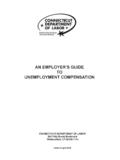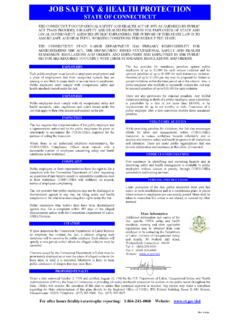Transcription of Info Sheet #1 Pictograms
1 Page 1 of 3 Globally Harmonized System (GHS) of Classification and Labeling of Chemicals Produced by SCHC-OHSA Alliance GHS Fact Information Sheet Workgroup What are Pictograms ? Generally speaking, a pictogram is a symbol or picture which represents a word or idea. We see Pictograms everyday in signs and labels. We are all familiar with the No Smoking pictogram posted in public buildings. and the No diving signs painted on the decks of swimming pools. The Department of Transportation (DOT) routinely requires labels with Pictograms for vehicles carrying hazardous materials. How does the GHS define Pictograms ? The distinction between pictogram and symbol is important: Certain circumstances require a pictogram, while others require only the symbol or pictogram name. Under the GHS, a pictogram is a graphical composition representation that includes a symbol plus other graphic elements, such as a border, background pattern or color intended to convey specific information.
2 In the most basic terms, a pictogram is a picture plus a border used to convey information. See the GHS Pictograms on the next page. A symbol is a graphical element intended to succinctly convey information it is the picture or graphic without the border or background color. See When are Pictograms and symbols required under the GHS? below. When are Pictograms and symbols required under the GHS? Labels When chemicals meet classification criteria under any of the hazard classes identified by the GHS, the corresponding pictogram must be printed on the chemical label. The Pictograms must have a black symbol on a white background with a red border frame. A black frame may be used for shipments within one country if authorized by the competent authority. Where transport Pictograms are required ( under the DOT Hazardous Materials Regulations), the GHS pictogram for the same hazard should not appear.
3 MSDSs The Pictograms or symbols based on chemical hazards may appear on the MSDS. Alternately, the pictogram name(s) may be listed. Pictogram Example Pictogram Name: Exclamation Mark info Sheet # 1 pictograms January, 2010 Page 2 of 3 GHS Pictograms and their Corresponding Chemical Hazards Name Hazard Name Hazard Exploding Bomb Explosive (Unstable, Divisions , , and ), Self Reactive (Type A and B), Organic Peroxide (Type A and B) Corrosive Corrosive (Skin Corrosion Categories 1A, 1B and 1C, Eye Corrosion Category 1), Corrosive to metals. Flame Flammable (Solids Categories 1 and 2, Liquids Categories 1, 2 and 3, Gases Category 1, Flammable Aerosols Categories 1 and 2), Self Reactive (Type B, C, D, E and F), Pyrophoric, Self-heating, Emits Flammable Gas, Organic Peroxide (Type B, C, D, and F) Skull Acute toxicity (Categories 1, 2, and 3) Flame over Circle Oxidizer Exclamation Mark Irritant (Skin Irritation Category 2 and Eye Irritation Category 2A), Dermal Sensitizer (Category 1), Acute Toxicity (Category 4, harmful), Target Organ Toxicity/ STOT Category 3 = narcotic effects, respiratory irritation Gas Cylinder Gas under pressure Chronic Health Hazard Carcinogen (Categories 1A, 1B, and 2), Respiratory Sensitizer (Category 1), Reproductive Toxicity (Categories 1A, 1B, and 2), Target Organ Toxicity/STOT (Categories 1 and 2), Mutagenicity (Categories 1A, 1B and 2)
4 , Aspiration Toxicity (Categories 1 and 2) Page 3 of 3 Additional Pictograms OSHA does not have jurisdiction over environmental hazards, and the following GHS pictogram will not be covered by OSHA. It may be covered by other agencies once those decisions have been made, and is provided for informational purposes. Environmental Hazard Acute Aquatic Toxicity (Category 1), Chronic Aquatic Toxicity (Categories 1and 2) To learn more .. The GHS, in its entirety (including classification criteria and label and MSDS requirements), can be downloaded at: OSHA s Notice of Proposed Rulemaking on the GHS is available at: A 12-hour training course on the GHS is offered by the Society for Chemical Hazard Communication (SCHC): For information sheets on additional GHS topics: OSHA site: #documents - go to 'Products and Resources'. or SCHC site: - see 'GHS Information Sheets'.
5 The OSHA Guide to the Globally Harmonized System of Classification and Labeling of Chemicals is available at: The information contained in this Sheet is believed to accurately represent provisions of regulations, consensus standards, and current GHS requirements. However, SCHC cannot guarantee the accuracy or completeness of this information. Users are responsible for determining the suitability and appropriateness of these materials for any particular application. This Sheet was developed through OSHA s Alliance Program for informational purposes only. It does not necessarily reflect the official views of OSHA or the Department of Labor.














